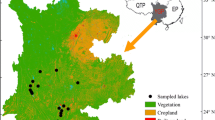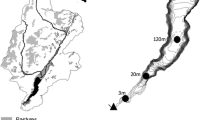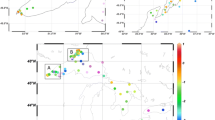Abstract
Intensification of catchment agriculture has increased nutrient loads and accelerated eutrophication in some lakes, often resulting in episodic harmful algal blooms or prolonged periods of anoxia. The influence of catchment agriculture on lake sediment denitrification capacity as a nitrogen (N) removal mechanism in lakes is largely unknown, particularly in contrast to research on denitrification in agricultural streams and rivers. We measured denitrification enzyme activity (DEA) to assess sediment denitrification potential in seven monomictic and three polymictic lakes that range in the proportion of agriculture in the catchment from 3 to 96% to determine if there is a link between agricultural land use in the lake catchment and sediment denitrification potential. We collected sediment cores for DEA measurements over 3 weeks in austral spring 2008 (October–November). Lake Okaro, with 96% catchment agriculture, had approximately 15 times higher DEA than Lake Tikitapu, with 3% catchment agriculture (232.2 ± 55.9 vs. 15.9 ± 4.5 μg N gAFDM−1 h−1, respectively). Additionally, sediment denitrification potential increased with the proportion of catchment in agriculture (R 2 = 0.85, P < 0.001). Our data suggest that lakes retain a high capacity to remove excess N via denitrification under increasing N loads from higher proportions of catchment agriculture. However, evidence from the literature suggests that despite a high capacity for denitrification and longer water residence times, lakes with high N loads will still remove a smaller proportion of their N load. Lakes have a denitrification potential that reflects the condition of the lake catchment, but more measurements of in situ denitrification rates across lake catchments is necessary to determine if this capacity translates to high N removal rates.




Similar content being viewed by others
References
Abell JM, Özkundakci D, Hamilton DP. 2010. Nitrogen and phosphorus limitation of phytoplankton growth in New Zealand lakes: implications for eutrophication control. Ecosystems 13(7):966–77.
Adrian R, O’Reilly CM, Zagarese H, Baines SB, Hessen DO, Keller W, Livingstone DM, Sommaruga R, Straile D, Donk EV, Weyhenmeyer GA, Winder M. 2009. Lakes as sentinels of climate change. Limnol Oceanogr 54:2283–97.
Alexander RB, Bohlke JK, Boyer EW, David MB, Harvey JW, Mulholland PJ, Seitzinger SP, Tobias CR, Tonitto C, Wollheim WM. 2009. Dynamic modelling of nitrogen losses in river networks unravels the coupled effects of hydrological and biogeochemical processes. Biogeochemistry 93:91–116.
Allan MG, Hamilton DP, Hicks BJ, Brabyn L. Landsat remote sensing of chlorophyll a concentrations in central North Island lakes of New Zealand. Int J Remote Sens. doi:10.1080/01431161003645840.
Arango CP, Tank JL. 2008. Land use influences the spatiotemporal controls on nitrification and denitrification in headwater streams. J N Am Benthol Soc 27:90–107.
Arbuckle KE, Downing JA. 2001. The influence of watershed land use on lake N:P in a predominantly agricultural landscape. Limnol Oceanogr 46:970–5.
Bartkow ME, Udy JW. 2004. Quantifying potential nitrogen removal by denitrification in stream sediments at a regional scale. Mar Freshw Res 55:309–15.
Beyá J, Hamilton DP, Burger DF. 2005. Analysis of catchment hydrology and nutrient loads for lakes Rotorua and Rotoiti. CBER Contract Report No. 74. Centre for Biodiversity and Ecology Research, Hamilton, New Zealand.
Broussard W, Turner RE. 2009. A century of changing land-use and water-quality relationships in the continental US. Front Ecol Environ 7:302–7.
Bruesewitz DA, Tank JL, Hamilton SK. 2009. Seasonal effects of zebra mussels on littoral nitrogen transformation rates in Gull Lake, Michigan, U.S.A. Freshw Biol 54:1427–43.
Burger DF, Hamilton DP, Pilditch CA, Gibbs MM. 2007. Benthic nutrient fluxes in a eutrophic, polymictic lake. Hydrobiologia 584:13–25.
Burger DF, Hamilton DP, Pilditch CA. 2008. Modelling the relative importance of internal and external nutrient loads on water column nutrient concentrations and phytoplankton biomass in a shallow polymictic lake. Ecol Model 211:411–23.
Carpenter SR, Caraco NF, Correll DL, Howarth RW, Sharpley AN, Smith VH. 1998. Nonpoint pollution of surface waters with phosphorus and nitrogen. Ecol Appl 8:559–68.
Chen XX, Driscoll CT. 2009. Watershed land use controls on chemical inputs to Lake Ontario embayments. J Environ Qual 38:2084–95.
Craig LS, Palmer MA, Richardson DC, Filoso S, Bernhardt ES, Bledsoe BP, Doyle MW, Groffman PM, Hassett BA, Kaushal SS, Mayer PM, Smith SM, Wilcock PR. 2008. Stream restoration strategies for reducing river nitrogen loads. Front Ecol Environ 6:529–38.
Cronin J, Winters K, Curtis T. 2007. Lake Rotoehu action plan. The Rotorua Lakes Protection and Restoration Action Programme.
David MB, Gentry LE, Kovacic DA, Smith KM. 1997. Nitrogen balance in and export from an agricultural watershed. J Environ Qual 26:1038–48.
David MB, Wall LG, Royer TV, Tank JL. 2006. Denitrification and the nitrogen budget of a reservoir in an agricultural landscape. Ecol Appl 16:2177–90.
Downs TM, Schallenburg M, Burns CW. 2008. Responses of lake phytoplankton to micronutrient enrichment: a study in two New Zealand lakes and an analysis of published data. Aqu Sci 70:347–60.
Edgar N. 2009. Icon lakes in New Zealand: managing the tension between land development and water resource protection. Soc Nat Resour 22:1–11.
Fraterrigo JM, Downing JA. 2008. The influence of land use on lake nutrients varies with watershed transport capacity. Ecosystems 11:1021–34.
Galloway JN, Aber JD, Erisman JW, Seitzinger SP, Howarth RW, Cowling EB, Cosby BJ. 2003. The nitrogen cascade. Bioscience 53:341–56.
Groffman PM, Holland EA, Myrold DD, Robertson GP, Zou X. 1999. Denitrification. In: Robertson GP, Coleman DC, Bledsoe CC, Sollins P, Eds. Standard soil methods for long term ecological research. New York: Oxford University Press. p 272–88.
Groffman PM, Altabet MA, Bohlke JK, Butterbach-Bahl K, David MB, Firestone MK, Giblin AE, Kana TM, Nielsen LP, Voytek MA. 2006. Methods for measuring denitrification: diverse approaches to a difficult problem. Ecol Appl 16:2091–122.
Hadfield JC, Morgenstern U, Piper JJ. 2007. Delayed impacts of land-use via groundwater on Lake Taupo, New Zealand. In: Brebbia CA, Kungolos A, Eds. 4th international conference on water resource management. Ashurst, Kos: WIT Press. p 293–303.
Hagg D, Kaupenjohann M. 2001. Landscape fate of nitrate fluxes and emissions in central Europe - a critical review of concepts, data, and models for transport and retention. Agric Ecosys Environ 86:1–21.
Hamilton D. 2004. Land use impacts on nutrient export in the central volcanic plateau, North Island. N Z J For 49:27–31.
Hamilton DP, Hamilton M, McBride C. 2006. Nutrient and water budget for Lake Tarawera. CBER Contract Report No. 46. Centre for Biodiversity and Ecology Research, Hamilton, New Zealand.
Harms TK, Wentz EA, Grimm NB. 2009. Spatial heterogeneity of denitrification in semi-arid floodplains. Ecosystems 12:129–43.
Harrison JA, Maranger RJ, Alexander RB, Giblin AE, Jacinthe PA, Mayorga E, Seitzinger SP, Sobota DJ, Wollheim WM. 2009. The regional and global significance of nitrogen removal in lakes and reservoirs. Biogeochemistry 93:143–57.
Herrman KS, Bouchard V, Moore RH. 2008. An assessment of nitrogen removal from headwater streams in an agricultural watershed, northeast Ohio, USA. Limnol Oceanogr 53:2573–82.
Inwood SE, Tank JL, Bernot MJ. 2005. Patterns of denitrification associated with land use in 9 midwestern headwater streams. J N Am Benthol Soc 24:227–45.
Jeppesen E, Sondergaard M, Jensen JP, Havens KE, Anneville O, Carvalho L, Coveney MF, Deneke R, Dokulil MT, Foy B, Gerdeaux D, Hampton SE, Hilt S, Kangur K, Kohler J, Lammens EHHR, Lauridsen TL, Manca M, Miracle MR, Moss B, Noges P, Persson G, Phillips G, Portielje R, Schelske CL, Straile D, Tatrai I, Willen E, Winder M. 2005. Lake responses to reduced nutrient loading - an analysis of contemporary long-term data from 35 case studies. Freshw Biol 50:1747–71.
Jones RI, King L, Dent MM, Maberly SC, Gibson CE. 2004. Nitrogen stable isotope ratios in surface sediments, epilithon and macrophytes from upland lakes with differing nutrient status. Freshw Biol 49:382–91.
Kelly CA, Rudd JWM, Hesslein RH, Schindler DW, Dillon PJ, Driscoll CT, Gherini SA, Hecky RE. 1987. Prediction of biological acid neutralization in acid-sensitive lakes. Biogeochemistry 3:129–40.
Kemp MJ, Dodds WK. 2001. Centimeter-scale patterns in dissolved oxygen and nitrification rates in a prairie stream. J N Am Benthol Soc 20:347–57.
Lindau CW, Iwai RR, Delaune RD, Gambrell RP. 2009. Denitrification potential of lake sediment at the David Pond Mississippi River freshwater diversion site, USA. J Freshw Ecol 24:181–9.
Matias NG, Boavida MJ. 2005. Effects of catchment development on the trophic status of a deep and shallow reservoir in Portugal. Lake Reservoir Manage 21:350–60.
McColl RHS. 1972. Chemistry and trophic status of seven New Zealand lakes. N Z J Mar Freshw Res 6:399–447.
McCrackin ML, Elser JJ. 2010. Atmospheric nitrogen deposition influences denitrification and nitrous oxide production in lakes. Ecology 91:528–39.
Menneer JC, Ledgard SF, Gillingham AG. 2004. Land use impacts on nitrogen and phosphorus loss and management options for intervention. Client Report for Environment Bay of Plenty. Hamilton: AgResearch Ltd.
Monaghan RM, Hedley MJ, Di HJ, McDowell RW, Cameron KC, Ledgard SF. 2007. Nutrient management in New Zealand pastures- recent developments and future issues. N Z J Agric Res 50:181–201.
Mulholland PJ, Helton AM, Poole GC, Hall RO, Hamilton SK, Peterson BJ, Tank JL, Ashkenas LR, Cooper LW, Dahm CN, Dodds WK, Findlay SEG, Gregory SV, Grimm NB, Johnson SL, McDowell WH, Meyer JL, Valett HM, Webster JR, Arango CP, Beaulieu JJ, Bernot MJ, Burgin AJ, Crenshaw CL, Johnson LT, Niederlehner BR, O’Brien JM, Potter JD, Sheibley RW, Sobota DJ, Thomas SM. 2008. Stream denitrification across biomes and its response to anthropogenic nitrate loading. Nature 452:202–46.
Mulholland PJ, Hall RO Jr, Sobota DJ, Dodds WK, Findlay SEG, Grimm NB, Hamilton SK, McDowell WH, O’Brien JM, Tank JL, Ashkenas LR, Cooper LW, Dahm CN, Gregory SV, Johnson SL, Meyer JL, Peterson BJ, Poole GC, Valett HM, Webster JR, Arango CP, Beaulieu JJ, Bernot MJ, Burgin AJ, Crenshaw CL, Helton AM, Johnson LT, Niederlehner BR, Potter JD, Sheibley RD, Thomas SM. 2009. Nitrate removal in stream ecosystems measured by 15N addition experiments: denitrification. Limnol Oceanogr 54:666–80.
Müller B, Lotter AF, Sturm M, Ammann A. 1998. Influence of catchment quality and altitude on the water and sediment composition of 68 small lakes in central Europe. Aquat Sci 60:316–37.
Murray RE, Knowles R. 1999. Chloramphenicol inhibition of denitrifying enzyme activity in two agricultural soils. Appl Environ Microbiol 65:3487–92.
Nakano T, Tayasu I, Yamada Y, Hosono T, Igeta A, Hyodo F, Ando A, Saitoh Y, Tanaka T, Wada E, Yachi S. 2008. Effect of agriculture on water quality of Lake Biwa, Japan. Sci Total Environ 389:132–48.
Özkundakci D, Hamilton DP, Scholes P. 2010. Effect of intensive catchment and in-lake restoration procedures on phosphorus concentrations in a eutrophic lake. Ecol Eng doi:10.1016/j.ecoleng.2009.11.006.
Palliser C, Rutherford JC. 2009. Agricultural statistics and land cover/use maps for Rotorua. NIWA Client Report. Hamilton: National Institute of Water and Atmospheric Sciences.
Parfitt RL, Schipper LA, Baisden WT, Elliott AH. 2006. Nitrogen inputs and outputs for New Zealand in 2001 at national and regional scales. Biogeochemistry 80:71–88.
Piña-Ochoa E, Álvarez-Cobelas M. 2006. Denitrification in aquatic environments: a cross-system analysis. Biogeochemistry 81:111–30.
Pinay G, O’Keefe T, Edwards R, Naiman RJ. 2003. Potential denitrification activity in the landscape of a western alaska drainage basin. Ecosystems 6:336–43.
Richardson WB, Strauss EA, Bartsch LA, Monroe EM, Cavanaugh JC, Vingum L, Soballe DM. 2004. Denitrification in the Upper Mississippi River: Rates, controls, and contribution to the nitrate flux. Can J Fish Aquat Sci 61:1102–12.
Royer TV, Tank JL, David MB. 2004. Transport and fate of nitrate in headwater agricultural streams in Illinois. J Environ Qual 33:1296–304.
Rutherford JC, Schroer D, Timpany G. 2009. How much runoff do riparian wetlands affect? N Z J Mar Freshw Res 43:1079–94.
Saunders DL, Kalff J. 2001. Denitrification rates in the sediments of Lake Memphremagog, Canada-USA. Water Res 35:1897–904.
Schaller J, Royer TV, David MB, Tank JL. 2004. Denitrification associated with plants and sediments in an agricultural stream. J N Am Benthol Soc 23:667–76.
Schindler DW. 2006. Recent advances in the understanding and management of eutrophication. Limnol Oceanogr 51:356–63.
Seitzinger S, Harrison JA, Bohlke JK, Bouwman AF, Lowrance R, Peterson B, Tobias C, Drecht GV. 2006. Denitrification across landscapes and waterscapes: a synthesis. Ecol Appl 16:2064–90.
Shirley G. 2009. Lake Rotoma action plan. The Rotorua Lakes Protection and Restoration Action Programme.
Smith MS, Tiedje JM. 1979. Phases of denitrification following oxygen depletion in soil. Soil Biol Biochem 11:261–7.
Snelder T, Shankar U, Dey K, Hurren H. 2006. Development of variables for freshwater environments of New Zealand (FWENZ): lakes. Christchurch: National Institute of Water and Atmospheric Research Ltd.
Soranno PA, Hubler SL, Carpenter SR, Lathrop RC. 1996. Phosphorus loads to surface waters: a simple model to account for spatial pattern of land use. Ecol Appl 6:865–78.
Spooner DR, Maher W. 2009. Benthic sediment composition and nutrient cycling in an intermittently closed and open lake lagoon. J Mar Syst 75:33–45.
Steinman AD, Lamberti GA. 1996. Biomass and pigments of benthic algae. In: Hauer FR, Lamberti GA, Eds. Methods in stream ecology. San Diego (CA): Academic Press.
Strauss EA, Richardson WB, Cavanaugh JC, Bartsch LA, Kreiling RM, Standorf AJ. 2006. Variability and regulation of denitrification in an Upper Mississippi River backwater. J N Am Benthol Soc 25(3):596–606.
Tanner CC, Caldwell K, Ray D, McIntosh J. 2007. Constructing wetlands to treat nutrient-rich inflow to Lake Okaro, Rotorua. In: Proceedings of stormwater 2007: 5th South Pacific Stormwater conference, Auckland, New Zealand.
Taranu ZE, Gregory-Eaves I. 2008. Quantifying relationships among phosphorus, agriculture, and lake depth at an inter-regional scale. Ecosystems 11:715–25.
Tiedje JM. 1994. Denitrifiers. In: Weaver RW, Angle SJ, Bottomley PJ, Bezdicek DF, Smith S, Tabatabal MA, Wollum AGI, Eds. Methods of soil analysis, part 2. Microbiological and biochemical properties. Madison (WI): Soil Science Society of America, Inc. p 245–67.
Vincent WF, Gibbs MM, Dryden SJ. 1984. Accelerated eutrophication in a New Zealand lake: Lake Rotoiti, central North Island. N Z J Mar Freshw Res 18:431–40.
Von Schiller D, Marti E, Riera JL. 2009. Nitrate retention and removal in Mediterranean streams bordered by contrasting land uses: a N-15 tracer study. Biogeosciences 6:181–96.
Wall LG, Tank JL, Royer TV, Bernot MJ. 2005. Spatial and temporal variability in sediment denitrification within an agriculturally influenced reservoir. Biogeochemistry 76:85–111.
White E, Payne GW. 1977. Chlorophyll production, in response to nutrient additions, by the algae in Lake Taupo water. N Z J Mar Freshw Res 11:501–7.
White E, Payne G, Pickmere S, Woods P. 1991. Seasonal variation in nutrient limitation of the algal community in Lake Horowhenua, New Zealand. N Z J Mar Freshw Res 25:311–16.
White PA, Clausen B, Hunt B, Cameron S, Weir JJ. 2001. Groundwater-surface water interaction. In: Rosen MR, White PA, Eds. Groundwaters of New Zealand. Wellington: New Zealand Hydrological Society. p 133–60.
Williamson CE, Saros JE, Schindler DW. 2009. Sentinels of change. Science 323:887–8.
Wilson HF, Xenopoulos MA. 2009. Effects of agricultural land use on the composition of fluvial dissolved organic matter. Nat Geosci 2:37–41.
Wu G, Liu Y, Shao GF, Tang L, Wang GZ. 2008. Effects of land use on water quality of two high-altitude lakes and catchments in Yunnan Province, China. Int J Sust Dev World 15:534–42.
Acknowledgments
We thank Chris Isherwood, Lisa Pearson, Annie Barker, Warwick Powrie, Helle Sønderbo and Louise Iversen for their hard work in the field. We also thank Sören Warneke and Louise Stewart for water chemistry analyses, Mathew Allan for the site map, and Dave Kelly for water residence time data. Laura Taylor Johnson, Deniz Özkundakci, Patricia Soranno, and two anonymous reviewers provided constructive suggestions that greatly improved this manuscript. This work was funded through contract UOWX0505 from the New Zealand Foundation for Research, Science and Technology.
Author information
Authors and Affiliations
Corresponding author
Additional information
Author Contributions
DAB designed the study, performed research, analyzed data, and wrote the paper. DH and LS designed the study, analyzed data, and edited the manuscript.
Rights and permissions
About this article
Cite this article
Bruesewitz, D.A., Hamilton, D.P. & Schipper, L.A. Denitrification Potential in Lake Sediment Increases Across a Gradient of Catchment Agriculture. Ecosystems 14, 341–352 (2011). https://doi.org/10.1007/s10021-011-9413-2
Received:
Accepted:
Published:
Issue Date:
DOI: https://doi.org/10.1007/s10021-011-9413-2




